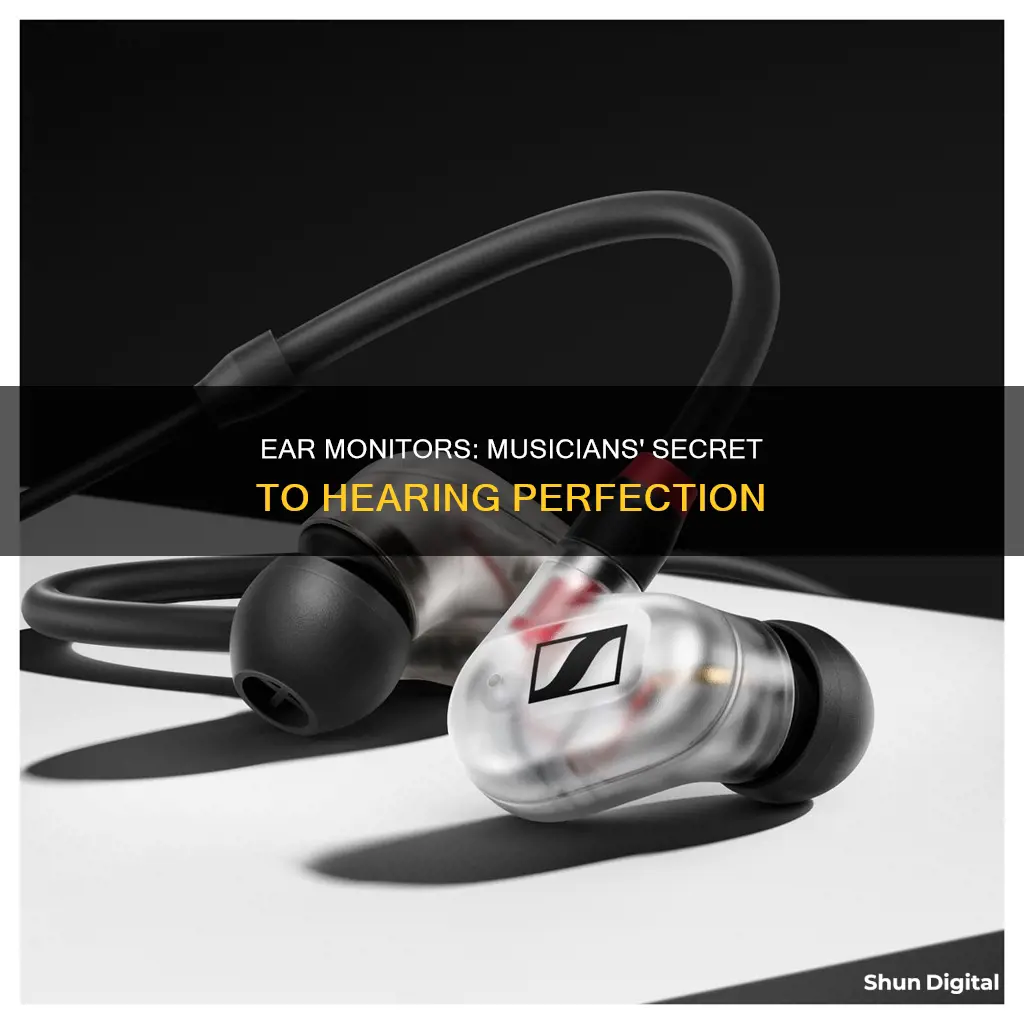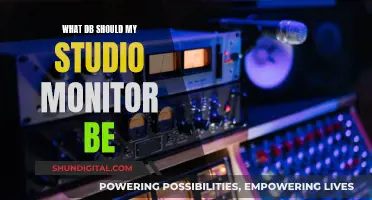
If you've ever been to a concert, you've probably noticed musicians and singers wearing earpieces. These devices are called in-ear monitors (IEMs) and they allow performers to hear their own performance without the obstruction of acoustic reflections. This helps them stay on key and on tempo, as they hear all instruments, including their own, clearly throughout the performance. IEMs also help to block out crowd noise and other distractions, allowing the musician to focus on their performance. Additionally, IEMs can provide hearing protection for musicians, reducing the risk of hearing damage from loud stage volumes.
| Characteristics | Values |
|---|---|
| Purpose | To hear their own performance without obstruction from acoustic reflections |
| To hear their own performance clearly | |
| To hear their own performance at a reasonable volume | |
| To hear their own performance without interference from other sounds | |
| To protect their hearing | |
| To receive directions from the production crew | |
| To hear a click track | |
| To reduce the risk of feedback | |
| To isolate the monitor mix from the audience mix | |
| To isolate individual monitor mixes from each other | |
| To reduce vocal strain | |
| To increase mobility |
What You'll Learn

To hear their own performance
In-ear monitors (IEMs) are a live monitoring option for musicians and singers to hear their own performance. They are an alternative to stage wedges, which are speakers that face the performers.
When on stage, a singer is usually facing the audience and hears the sound coming from the speakers bouncing off the venue's ceiling and walls. This can make it challenging for the performer to do their job well.
IEMs provide a clear and direct source of sound to the musician on stage. They also eliminate distractions, such as the noise from the drummer, that can impact performance. Singers can have the sound engineer put only their voice and, for example, the keyboard in their ears. This helps them make sure they stay on key and on tempo, as they hear all instruments, including their own, clearly throughout the performance.
IEMs also help performers isolate each of their custom-tailored monitoring mixes from one another. A monitor mix can be balanced in a way that helps each performer focus on their particular part. For example, a singer might be following the melody played by the lead guitarist and ask for the lead guitar to be turned up in their monitor mix. A bassist, on the other hand, may need to hear the kick drums louder than others.
LED vs LCD: Which Monitor Type Is Easier on the Eyes?
You may want to see also

To protect their hearing
Musicians and singers often wear in-ear monitors (IEMs) to protect their hearing. The devices fit snugly in the wearer's ear, creating a seal that blocks out the stage volume and the sound of the crowd. This seal, coupled with the device's sound fidelity, allows for high-quality monitoring at much lower levels, reducing the risk of hearing damage.
Performers need to hear what they are singing or playing clearly. Usually, performers on stage face the audience and, instead of hearing the sound coming from the speakers, they hear whatever sound is bouncing off the venue's ceiling and walls. This can make it challenging for the performer to do their job well and force them to strain their voice, which could result in vocal cord damage over time.
In-ear monitors provide a clear and direct source of sound to the musician on stage, allowing them to hear their performance without the obstruction of acoustic reflections. This helps them stay on key and on tempo, as they can hear all the instruments, including their own, clearly throughout the performance.
In-ear monitors also offer hearing protection. Musicians tend to suffer hearing loss at rates about four times higher than non-musicians, and they also tend to deal with tinnitus issues. Any sound over 85 decibels for extended periods increases the odds of hearing damage, and stage volumes can exceed 100 dB. In-ear monitors block out these amplified sounds, protecting the wearer's hearing.
The use of in-ear monitors can also prevent vocal strain. When singers are unable to hear their own voice over the band's instruments or the crowd noise, their first instinct may be to sing louder to compete with it. In-ear monitors reduce the need for the singer to strain their voice, protecting their hearing and vocal cords.
Dead Pixels: RMA Criteria for ASUS Monitors
You may want to see also

To reduce vocal strain
In-ear monitors (IEMs) are a live monitoring option for singers and musicians. They help to reduce vocal strain by allowing the wearer to hear their own performance without obstruction from other sounds, such as the band or the crowd.
When singers are unable to hear their own voice, they tend to sing louder to compensate, which can lead to vocal cord damage over time. IEMs prevent this by providing a clear and direct source of sound to the wearer, allowing them to hear their own voice and stay on key and on tempo.
With IEMs, singers can choose how much or how little of each instrument they hear. For example, they can have just their voice and a single instrument, such as the keyboard, playing in their ears. This helps to reduce the noise coming from other instruments, such as the drums, and prevents the singer from having to shout over them.
IEMs also create a seal in the performer's ear, blocking out stage volume and crowd noise, which can also help to reduce vocal strain by eliminating distractions and allowing the singer to focus on their performance.
Testing Monitors Before Buying: What You Need to Know
You may want to see also

To hear their custom-tailored mix
In-ear monitors (IEMs) allow musicians to hear a custom-tailored mix of their performance. This means that each musician can choose the individual mix that they want to hear. For example, a singer might want to hear mostly themselves, whereas a drummer may need to hear a click track to keep them on tempo.
IEMs are an alternative to stage wedges, which are speakers that face the performers on stage. Stage wedges have to compete with acoustic reflections, which can cause issues with phase interference and masking, resulting in a loss of clarity. IEMs, on the other hand, offer sound isolation, allowing musicians to hear their performance without obstruction or interference from other sounds.
IEMs also allow performers to isolate their custom-tailored monitoring mixes from one another. A monitor mix can be balanced to help each performer focus on their part. For example, a singer might want the lead guitarist's melody turned up in their monitor mix, while a bassist may need to hear the kick drums louder than others. With stage wedges, the mixes usually remain similar across the whole performance as they loudly bleed sound into the open air.
IEMs also reduce the risk of feedback loops. Speaker monitors can cause feedback when the audio from a singer's microphone comes out of the monitor and feeds back into the microphone, creating a perpetual loop. By keeping monitoring signals contained within the performer's ears, IEMs reduce the risk of feedback.
Blind-Spot Monitoring: Is It Available in Buick Models?
You may want to see also

To receive cues and directions
In-ear monitors (IEMs) are a crucial tool for musicians and performers, offering numerous benefits that enhance their live performances and protect their hearing health. One of the key advantages of IEMs is their ability to provide clear and direct communication of cues and directions to the wearer.
During a live performance, musicians and performers must stay synchronised and coordinated, and IEMs play a vital role in achieving this. The audio crew can transmit essential cues and directions directly to the performers' ears, ensuring everyone is literally on the same beat. This real-time communication is invaluable, especially when sudden changes or adjustments are required during the show.
For example, a singer might receive cues to start singing a particular verse or chorus, ensuring they are in sync with the band. Drummers may receive a click track or metronome in their monitors to maintain a steady tempo and synchronise with lighting or visual cues. In more complex performances, such as musicals or theatre productions, performers may even receive spoken directions or their next lines fed to them through the IEMs.
The ability to receive cues and directions through IEMs is especially advantageous in high-energy performances where adrenaline is pumping, and it can be challenging to remember all the details of the performance. It also ensures that performers can focus on their craft without worrying about missing a cue or forgetting a direction.
Additionally, IEMs allow each performer to customise their monitor mix. For instance, a singer may want to hear mostly their voice, while a drummer might need to hear the kick drum and bass guitar for the rhythm. This customisation ensures that each performer receives the information they need to stay on track and deliver their best performance.
In conclusion, IEMs are not just about protecting hearing and enhancing sound quality; they are also a powerful tool for facilitating effective communication of cues and directions, ensuring that live performances run smoothly and professionally.
Hooking up Three Monitors to a GTX 970: Ultimate Guide
You may want to see also
Frequently asked questions
Musicians and performers wear ear monitors, or in-ear monitors (IEMs), to help them hear their own performance without the obstruction of acoustic reflections, so they can stay on key and on tempo.
Ear monitors allow musicians to hear their performance clearly, without the warped reflections from the venue's surfaces that can occur with stage wedges (speakers that face the performer). They also help to reduce vocal strain, protect hearing, and increase mobility on stage.
Ear monitors create a seal on the performer's ear to block out crowd noise and other distractions, allowing them to focus on their own performance and the specific mix of instruments they want to hear.
There are a few reasons why a musician might remove their ear monitor during a performance. This could be due to technical malfunctions, a poor monitor mix, or because they want to hear the crowd and feel more connected to the audience.







